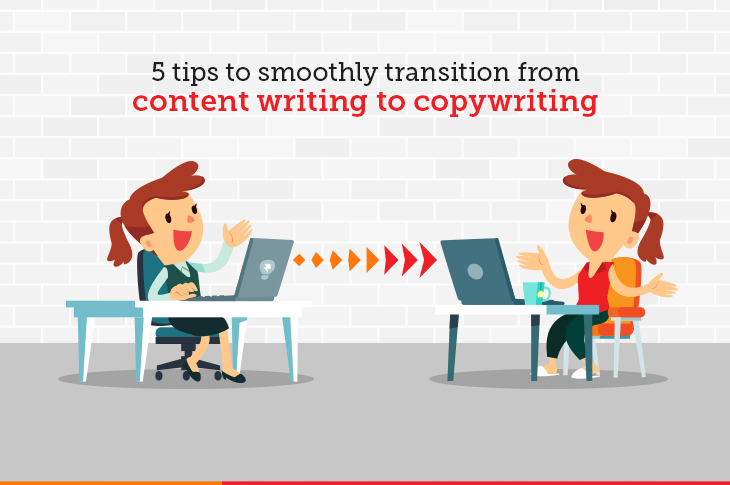5 tips to smoothly transition from content writing to copywriting

Content has taken the world by storm. As a content writer yourself, you know its importance in modern marketing. From BFSI companies trying to educate people to be more financially secure to personal care brands teaching people about skincare, everybody is employing content to reach their audience. This also means that more and more people with an inclination towards or talent for writing are moving into content writing. If you are good at doing your research, explaining things in simpler terms, and weaving a good story, you are probably already a great content writer. But what about another popular, and much older, format for marketing writing – copywriting?

How good are you at copywriting?
While content is growing, copy still holds its position, and advertisers need good copywriters now more than ever. Having said that, these are two very different disciplines, with diverse goals, formats, and approaches. So, it is possible that you might face some problems transitioning to copywriting from content writing. But worry not, this article aims to help you enter (and conquer) the world of copywriting with five simple steps. But before we do that, let us first understand the difference between the two.
Difference between content writing and copywriting
There are several key differences that set the two apart, and here are some.
| Content writing
| Copywriting
| |
| Length | Mostly long-form writing. It can range anywhere between 300 to 3000 words. | Short-form writing, ranging on an average from as little as 10 words to a couple of hundred words. |
| Style | Descriptive writing with a focus on sharing information. | Snippets and tag lines with a focus of saying more with less. |
| Goal | To educate, inform and create awareness among the target audience. | To persuade and sell something to the target audience. |
| Formats | A content writer writes articles, blogs, whitepapers, infographics, video scripts, e-books, social media content, reports, newsletters, etc. | A copywriter writes advertisement copy for TV, online media, billboards, in addition to taglines for brands, creative banner ads, jingles and more. |
| Skillset | In-depth subject matter knowledge, good research skills and strong storytelling skills. | A creative mind and persuasive approach to nudge the reader towards an action. |
Tips to start your journey in copywriting
Learn to say more with few words: When it comes to copy, you need to create the maximum impact with as few words as possible. The key here is to be concise, to the point and often a little witty. There is a reason “punchy” is an adjective used for a copy because like a good punch it should be powerful, quick, and with minimal contact time. Take Hiut Denim’s copy where they proudly announce that they only make jeans and nothing else.

Be persuasive and focus on the sales aspect: The goal of a copy is simple and straightforward – to sell. To be able to do so, it has to make a compelling case for the brand. Hence, when writing a copy, lay focus on why one should buy the product or service. A successful commercial that comes to mind is Complan’s ‘I am a Complan boy’ and ‘I am a Complan girl’. The ad targeted mothers and told them about its nutritional value and instilled in them that every growing kid needs Complan. This ad played a huge role in selling and making Complan a household name.
Don’t be afraid of breaking the rules: With so many restrictions to work with, mainly the word count, you cannot always be following the rules of writing. So, in the case of copy, don’t get too hung up on rules of structure, style or even grammar. Otherwise, your copy might end up being too verbose and boring. And not just the rules of writing, don’t be afraid of breaking the rules of marketing as well.
Take this 1959 Volkswagen campaign where they presented a small car as a good option when all of America was gaga over muscle cars.

Cater to the emotions of the reader: Write a copy that sparks an emotion – joy, humor, empathy, etc. It is important because emotions are finally what make sales. Not logic, not information but emotions. One way of doing this is by talking directly to your audience’s desires, aspirations, and pain points. Take Nike for example and recall how motivating all their campaigns and copy are. Instead of selling you the shoes, they motivate you to be active.

Another way of doing this is by weave a current affair or cultural nuance that people feel very strongly about in your brand message. Amul’s topical copywriting is a perfect testament to this.
Practice your CTAs: CTA stands for Call To Action, which means urging the customer to take the desired action. A good copywriter needs to master the art of writing effective CTA. There are many ways to do so. You can use powerful words such as ‘Try now’ or ‘Order before stock runs out. You can also give them a good reason to take action or use their FOMO against them by saying ‘Sale lasts only 8 hours. Lastly, don’t be afraid to get creative with your CTA. Instead of a simple ‘Buy now’, you can say something that stands out. For example, Basecamp takes a very conversational but yet unique approach to their CTA.

Lastly, study a lot of successful copy written by ad legends. Try to figure out what makes these copies click and emulate their mantra. Remember, becoming a pro at copywriting takes time and practice. Start by using these tried and tested formulas and learn along the way.
Relevant Links:
1. https://www.entrepreneur.com/article/247908
2. https://scatter.co.in/8-stages-involved-in-the-creation-of-content-before-it-goes-live/
Contributors: Aditya Kumar, Sanchea D’Souza and Swapnil Adsul
